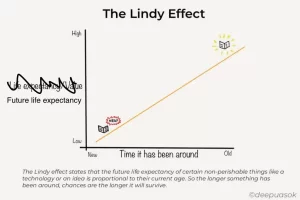Who here has considered the Lindy Effect when evaluating fast lane business ideas?
The Lindy Effect says that if something has existed for x number of years, you can reasonably expect it to exist for that same number of years into the future. More info on the idea in this video, article, and academic article.

I think it's something really valuable to consider when qualifying your business ideas along with the CENTS framework.
You can also apply it to different aspects of your business. So for example, let's say I found a need want to build an app that helps solve it, and that I plan to build an app/website to help animal shelters find people to adopt animals. I could ask:
You can also apply it to different aspects of your business. So for example, let's say I found a need want to build an app that helps solve it, and that I plan to build an app/website to help animal shelters find people to adopt animals. I could ask:
- Is the need lindy?
- how long have animal shelters existed?
- for how long have people wanted pets?
- Is the method of delivery lindy?
- how long have apps been around?
- how long have different app distributors been around?
- how long have websites been around? (I know some of these sound is kind of ridiculous lol, but I think it's still worth considering)
While there's no guarantee that things will exist into the future, it does help you to consider the longevity of your endeavour, and it might help with a few decisions.
Would love to hear anyones thoughts on what other aspects of a business this could be applied to (or anything else for that matter).
Would love to hear anyones thoughts on what other aspects of a business this could be applied to (or anything else for that matter).
Dislike ads? Become a Fastlane member:
Subscribe today and surround yourself with winners and millionaire mentors, not those broke friends who only want to drink beer and play video games. :-)
Membership Required: Upgrade to Expose Nearly 1,000,000 Posts
Ready to Unleash the Millionaire Entrepreneur in You?
Become a member of the Fastlane Forum, the private community founded by best-selling author and multi-millionaire entrepreneur MJ DeMarco. Since 2007, MJ DeMarco has poured his heart and soul into the Fastlane Forum, helping entrepreneurs reclaim their time, win their financial freedom, and live their best life.
With more than 39,000 posts packed with insights, strategies, and advice, you’re not just a member—you’re stepping into MJ’s inner-circle, a place where you’ll never be left alone.
Become a member and gain immediate access to...
- Active Community: Ever join a community only to find it DEAD? Not at Fastlane! As you can see from our home page, life-changing content is posted dozens of times daily.
- Exclusive Insights: Direct access to MJ DeMarco’s daily contributions and wisdom.
- Powerful Networking Opportunities: Connect with a diverse group of successful entrepreneurs who can offer mentorship, collaboration, and opportunities.
- Proven Strategies: Learn from the best in the business, with actionable advice and strategies that can accelerate your success.
"You are the average of the five people you surround yourself with the most..."
Who are you surrounding yourself with? Surround yourself with millionaire success. Join Fastlane today!
Join Today


